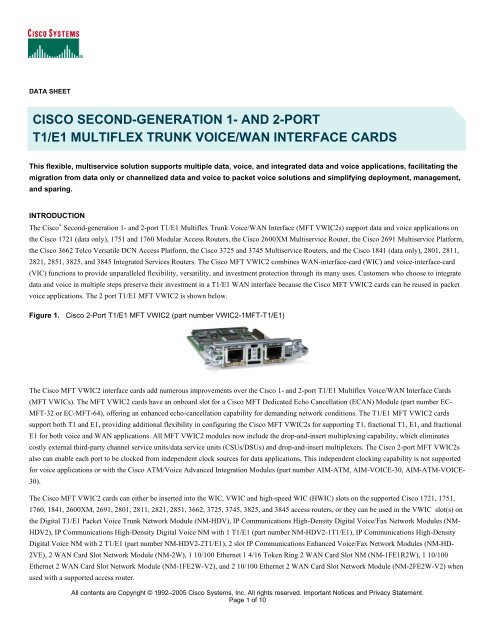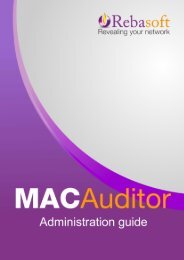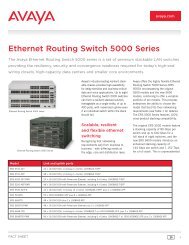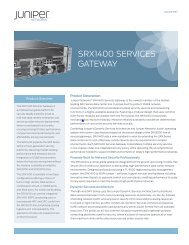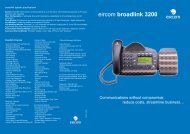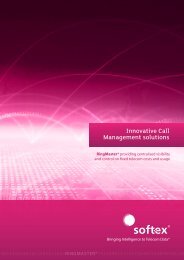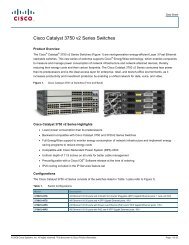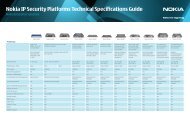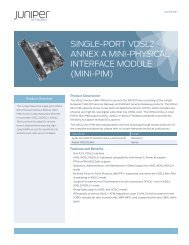and 2-port t1/e1 multiflex trunk voice/wan interface cards - Cisco
and 2-port t1/e1 multiflex trunk voice/wan interface cards - Cisco
and 2-port t1/e1 multiflex trunk voice/wan interface cards - Cisco
- No tags were found...
Create successful ePaper yourself
Turn your PDF publications into a flip-book with our unique Google optimized e-Paper software.
DATA SHEET<br />
CISCO SECOND-GENERATION 1- AND 2-PORT<br />
T1/E1 MULTIFLEX TRUNK VOICE/WAN INTERFACE CARDS<br />
This flexible, multiservice solution sup<strong>port</strong>s multiple data, <strong>voice</strong>, <strong>and</strong> integrated data <strong>and</strong> <strong>voice</strong> applications, facilitating the<br />
migration from data only or channelized data <strong>and</strong> <strong>voice</strong> to packet <strong>voice</strong> solutions <strong>and</strong> simplifying deployment, management,<br />
<strong>and</strong> sparing.<br />
INTRODUCTION<br />
The <strong>Cisco</strong> ® Second-generation 1- <strong>and</strong> 2-<strong>port</strong> T1/E1 Multiflex Trunk Voice/WAN Interface (MFT VWIC2s) sup<strong>port</strong> data <strong>and</strong> <strong>voice</strong> applications on<br />
the <strong>Cisco</strong> 1721 (data only), 1751 <strong>and</strong> 1760 Modular Access Routers, the <strong>Cisco</strong> 2600XM Multiservice Router, the <strong>Cisco</strong> 2691 Multiservice Platform,<br />
the <strong>Cisco</strong> 3662 Telco Versatile DCN Access Platform, the <strong>Cisco</strong> 3725 <strong>and</strong> 3745 Multiservice Routers, <strong>and</strong> the <strong>Cisco</strong> 1841 (data only), 2801, 2811,<br />
2821, 2851, 3825, <strong>and</strong> 3845 Integrated Services Routers. The <strong>Cisco</strong> MFT VWIC2 combines WAN-<strong>interface</strong>-card (WIC) <strong>and</strong> <strong>voice</strong>-<strong>interface</strong>-card<br />
(VIC) functions to provide unparalleled flexibility, versatility, <strong>and</strong> investment protection through its many uses. Customers who choose to integrate<br />
data <strong>and</strong> <strong>voice</strong> in multiple steps preserve their investment in a T1/E1 WAN <strong>interface</strong> because the <strong>Cisco</strong> MFT VWIC2 <strong>cards</strong> can be reused in packet<br />
<strong>voice</strong> applications. The 2 <strong>port</strong> T1/E1 MFT VWIC2 is shown below.<br />
Figure 1. <strong>Cisco</strong> 2-Port T1/E1 MFT VWIC2 (part number VWIC2-1MFT-T1/E1)<br />
The <strong>Cisco</strong> MFT VWIC2 <strong>interface</strong> <strong>cards</strong> add numerous improvements over the <strong>Cisco</strong> 1- <strong>and</strong> 2-<strong>port</strong> T1/E1 Multiflex Voice/WAN Interface Cards<br />
(MFT VWICs). The MFT VWIC2 <strong>cards</strong> have an onboard slot for a <strong>Cisco</strong> MFT Dedicated Echo Cancellation (ECAN) Module (part number EC-<br />
MFT-32 or EC-MFT-64), offering an enhanced echo-cancellation capability for dem<strong>and</strong>ing network conditions. The T1/E1 MFT VWIC2 <strong>cards</strong><br />
sup<strong>port</strong> both T1 <strong>and</strong> E1, providing additional flexibility in configuring the <strong>Cisco</strong> MFT VWIC2s for sup<strong>port</strong>ing T1, fractional T1, E1, <strong>and</strong> fractional<br />
E1 for both <strong>voice</strong> <strong>and</strong> WAN applications. All MFT VWIC2 modules now include the drop-<strong>and</strong>-insert multiplexing capability, which eliminates<br />
costly external third-party channel service units/data service units (CSUs/DSUs) <strong>and</strong> drop-<strong>and</strong>-insert multiplexers. The <strong>Cisco</strong> 2-<strong>port</strong> MFT VWIC2s<br />
also can enable each <strong>port</strong> to be clocked from independent clock sources for data applications. This independent clocking capability is not sup<strong>port</strong>ed<br />
for <strong>voice</strong> applications or with the <strong>Cisco</strong> ATM/Voice Advanced Integration Modules (part number AIM-ATM, AIM-VOICE-30, AIM-ATM-VOICE-<br />
30).<br />
The <strong>Cisco</strong> MFT VWIC2 <strong>cards</strong> can either be inserted into the WIC, VWIC <strong>and</strong> high-speed WIC (HWIC) slots on the sup<strong>port</strong>ed <strong>Cisco</strong> 1721, 1751,<br />
1760, 1841, 2600XM, 2691, 2801, 2811, 2821, 2851, 3662, 3725, 3745, 3825, <strong>and</strong> 3845 access routers, or they can be used in the VWIC slot(s) on<br />
the Digital T1/E1 Packet Voice Trunk Network Module (NM-HDV), IP Communications High-Density Digital Voice/Fax Network Modules (NM-<br />
HDV2), IP Communications High-Density Digital Voice NM with 1 T1/E1 (part number NM-HDV2-1T1/E1), IP Communications High-Density<br />
Digital Voice NM with 2 T1/E1 (part number NM-HDV2-2T1/E1), 2 slot IP Communications Enhanced Voice/Fax Network Modules (NM-HD-<br />
2VE), 2 WAN Card Slot Network Module (NM-2W), 1 10/100 Ethernet 1 4/16 Token Ring 2 WAN Card Slot NM (NM-1FE1R2W), 1 10/100<br />
Ethernet 2 WAN Card Slot Network Module (NM-1FE2W-V2), <strong>and</strong> 2 10/100 Ethernet 2 WAN Card Slot Network Module (NM-2FE2W-V2) when<br />
used with a sup<strong>port</strong>ed access router.<br />
All contents are Copyright © 1992–2005 <strong>Cisco</strong> Systems, Inc. All rights reserved. Im<strong>port</strong>ant Notices <strong>and</strong> Privacy Statement.<br />
Page 1 of 10
The <strong>Cisco</strong> MFT VWIC2 <strong>cards</strong> are offered in single- <strong>and</strong> dual-<strong>port</strong> versions, which can be used <strong>and</strong> then redeployed as network requirements change,<br />
thereby addressing several applications:<br />
• T1/E1 data---The <strong>Cisco</strong> 1- <strong>and</strong> 2- <strong>port</strong> T1/E1 MFT VWIC2 versions act as a WIC, sup<strong>port</strong>ing T1, fractional T1, E1, (including structured G.703<br />
with G.704 framing), fractional E1, <strong>and</strong> E1structured G.703 applications. To simplify remote management, these MFT VWIC2 <strong>cards</strong> integrate a<br />
fully managed DSU/CSU for T1 deployments <strong>and</strong> a fully managed DSU for E1 deployments.<br />
• E1/G.703 data---The <strong>Cisco</strong> 1- <strong>and</strong> 2- <strong>port</strong> G.703 MFT VWIC2 versions act as a WIC, sup<strong>port</strong>ing T1, fractional T1, E1 (including structured<br />
G.703 with G.704 framing), fractional E1, <strong>and</strong> unstructured E1 (G.703) applications. To simplify remote management, the G.703 version includes<br />
a fully managed DSU. The G.703 versions also sup<strong>port</strong> all the capabilities on the T1/E1 versions.<br />
• T1/E1 packet <strong>voice</strong>---The <strong>Cisco</strong> 1- <strong>and</strong> 2- <strong>port</strong> T1/E1 MFT VWIC2 (<strong>voice</strong> <strong>and</strong> WAN) versions act as a VIC, sup<strong>port</strong>ing packet <strong>voice</strong> applications<br />
by providing T1, fractional T1, E1, <strong>and</strong> fractional E1 connections to private branch exchanges (PBXs) <strong>and</strong> central offices, thereby enabling new<br />
services <strong>and</strong> reducing <strong>voice</strong> <strong>and</strong> fax toll charges.<br />
• Mixed data <strong>and</strong> packet <strong>voice</strong>---The <strong>Cisco</strong> MFT VWIC2 <strong>interface</strong> <strong>cards</strong> can simultaneously sup<strong>port</strong> both data <strong>and</strong> <strong>voice</strong>, reducing the complexity<br />
<strong>and</strong> number of network components <strong>and</strong> facilitating a graceful migration to b<strong>and</strong>width-efficient packet <strong>voice</strong>.<br />
• Mixed data <strong>and</strong> packet <strong>voice</strong> with drop <strong>and</strong> insert---The <strong>Cisco</strong> MFT VWIC2 <strong>cards</strong> can be deployed as a T1/E1 drop-<strong>and</strong>-insert multiplexer<br />
with integrated DSUs/CSUs, reducing the complexity of the network <strong>and</strong> the cost of the central-office <strong>port</strong>s by efficiently combining timedivision<br />
multiplexing (TDM) <strong>voice</strong> (PBX), IP <strong>voice</strong>, <strong>and</strong> data on the same <strong>trunk</strong>s. Note the <strong>Cisco</strong> 1721, 1751 <strong>and</strong> 1760 sup<strong>port</strong> drop <strong>and</strong> insert<br />
between two <strong>port</strong>s over a single VWIC2 card while <strong>Cisco</strong> 2800 <strong>and</strong> 3800 ISR routers sup<strong>port</strong>s drop <strong>and</strong> insert between two <strong>port</strong>s over a single<br />
VWIC2 card <strong>and</strong> two <strong>port</strong>s over two different VWICs.<br />
KEY BENEFITS<br />
Reduces Networking Lifecycle Costs<br />
• Enables graceful migration from data-only to multiplexed data <strong>and</strong> <strong>voice</strong> to packetized <strong>voice</strong> applications<br />
• Reduces training, deployment, management, <strong>and</strong> sparing inventory over single-purpose <strong>interface</strong>s<br />
• Maximizes investment protection<br />
• Simplifies network configuration <strong>and</strong> sparing through the sup<strong>port</strong> of both T1 <strong>and</strong> E1 on the same card<br />
• Offers multifunction sup<strong>port</strong> for LAN-to-LAN routing, multiplexed data <strong>and</strong> <strong>voice</strong>, <strong>and</strong> packetized <strong>voice</strong><br />
• Offers ability to share modules between <strong>Cisco</strong> 1700, 1800, 2800 <strong>and</strong> 3700 series <strong>and</strong> <strong>Cisco</strong> 3800 routers, select <strong>Cisco</strong> 2600 <strong>and</strong> 3600 series<br />
routers, <strong>and</strong> select network modules (refer to Table 1 for details)<br />
• Increases configuration flexibility <strong>and</strong> reduces cost for data applications by allowing individual <strong>port</strong>s to be clocked from independent clock<br />
sources (not sup<strong>port</strong>ed for <strong>voice</strong> <strong>and</strong> not sup<strong>port</strong>ed with ATM/Voice Advanced Integration Module (part number AIM-ATM-VOICE-30) with<br />
ATM/Voice Advanced Integration Module (part number AIM-ATM, AIM-VOICE-30, AIM-ATM-VOICE-30)<br />
• Sup<strong>port</strong>s E1 configurations for both balanced <strong>and</strong> unbalanced modes<br />
• Sup<strong>port</strong>s (G.703 models) unstructured E1 (G.703) for using the full 2.048 Mbps<br />
• Eliminates costly external third-party CSUs/DSUs <strong>and</strong> drop-<strong>and</strong>-insert multiplexers<br />
• Provides optional sup<strong>port</strong> of a <strong>Cisco</strong> MFT Dedicated ECAN Module for dem<strong>and</strong>ing network conditions<br />
• Simplifies remote network management by allowing a single management tool such as <strong>Cisco</strong>View or <strong>Cisco</strong>Works to sup<strong>port</strong> router, CSU/DSU,<br />
or drop-<strong>and</strong>-insert multiplexer<br />
Maximizes System Resources<br />
• Increases T1/E1 <strong>port</strong> density on the sup<strong>port</strong>ed <strong>Cisco</strong> 1700, 1800, 2600, 2800, 3600, 3700, <strong>and</strong> 3800 access routers---up to four T1/E1 connections<br />
with an integrated CSU/DSU in a single network-module slot or up to two T1/E1 connections in a single WIC slot<br />
• Offers easy migration to b<strong>and</strong>width-efficient packet <strong>voice</strong>, enabling new services<br />
Customers who choose to integrate data <strong>and</strong> <strong>voice</strong> in stages to preserve their investment in WAN <strong>interface</strong>s. For example, the <strong>Cisco</strong> MFT VWIC2<br />
can sup<strong>port</strong> data-only applications as a WAN <strong>interface</strong>, <strong>and</strong> then be reused to integrate data <strong>and</strong> <strong>voice</strong> with the drop-<strong>and</strong>-insert multiplexer function<br />
or configured to sup<strong>port</strong> packetized <strong>voice</strong> (<strong>voice</strong> over IP [VoIP] or <strong>voice</strong> over Frame Relay [VoFR]) when installed in the Digital T1/E1 Packet<br />
© 2005 <strong>Cisco</strong> Systems, Inc. All rights reserved.<br />
Im<strong>port</strong>ant notices, privacy statements, <strong>and</strong> trademarks of <strong>Cisco</strong> Systems, Inc. can be found on cisco.com.<br />
Page 2 of 11
Voice Trunk Network Module (NM-HDV), 2 slot IP Communications Enhanced Voice/Fax Network Module (NM-HD-2VE), or IP<br />
Communications High-Density Digital Voice/Fax Network Module (NM-HDV2), IP Communications High-Density Digital Voice NM with 1<br />
T1/E1 (part number NM-HDV2-1T1/E1), IP Communications High-Density Digital Voice NM with 2 T1/E1 (part number NM-HDV2-2T1/E1).<br />
APPLICATIONS<br />
Packet Voice Solutions: PBX <strong>and</strong> Central-Office Connectivity<br />
The <strong>Cisco</strong> MFT VWIC2 <strong>interface</strong> <strong>cards</strong>, through its digital T1/E1 <strong>port</strong>s, supply PBX <strong>and</strong> public-switched-telephone-network (PSTN) connectivity<br />
for the Digital T1/E1 Packet Voice Trunk Network Module (NM-HDV), 2 slot IP Communications Enhanced Voice/Fax Network Modules (NM-<br />
HD-2VE), IP Communications High-Density Digital Voice/Fax Network Modules (NM-HDV2), IP Communications High-Density Digital Voice<br />
NM with 1 T1/E1 (part number NM-HDV2-1T1/E1), IP Communications High-Density Digital Voice NM with 2 T1/E1 (part number NM-HDV2-<br />
2T1/E1), <strong>and</strong> access routers with on-board VIC/WIC/HWIC slots. The NM-HDV, NM-HD-2VE, NM-HDV2, NM-HDV2-1T1/E1, NM-HDV2-<br />
2T1/E1, <strong>and</strong> access routers sup<strong>port</strong> H.323-, Session Initiation Protocol (SIP)-, Media Gateway Control Protocol (MGCP)-, <strong>and</strong> Skinny Client<br />
Control Protocol (SCCP)-based VoIP-, FRF.11-, <strong>and</strong> FRF.12-based VoFR, <strong>and</strong> ATM Adaption Layer 5 (AAL5)-based <strong>voice</strong>-over-ATM (VoATM)<br />
industry st<strong>and</strong>ards.<br />
Note: For each of these packet <strong>voice</strong> applications (VoIP, VoFR, or VoATM), an appropriate WIC also is required.<br />
Packet Voice Solutions: Echo Cancellation for Dem<strong>and</strong>ing Network Conditions<br />
The <strong>Cisco</strong> MFT VWIC2 <strong>interface</strong> <strong>cards</strong> have an onboard slot for a 32- or 64-channel <strong>Cisco</strong> MFT Dedicated ECAN Module (part number EC-MFT-<br />
32 or EC-MFT-64) (see Figure 2). These optional daughter <strong>cards</strong> provide a dedicated hardware resource that runs the <strong>Cisco</strong> Enhanced ITU-T G.168<br />
ECAN feature. The processing <strong>and</strong> memory resources of the dedicated ECAN module help enable configuration of the echo canceller with<br />
predefined settings <strong>and</strong> an extended 128-ms echo tail buffer, providing a robust echo-cancellation performance for dem<strong>and</strong>ing network<br />
environments. The 32- <strong>and</strong> 64-channel configurations of the dedicated ECAN modules match the requirements of the <strong>Cisco</strong> 1- <strong>and</strong> 2-<strong>port</strong> MFT<br />
VWIC2 <strong>cards</strong>, respectively.<br />
Figure 2. <strong>Cisco</strong> 2-Port T1/E1 MFT VWIC2 (part number VWIC2-2MFT-T1/E1) with an Optional 64-Channel MFT Dedicated ECAN<br />
Module (part number EC-MFT-64)<br />
Data Solutions: 1- <strong>and</strong> 2-Port T1/E1 WIC with Integrated DSU/CSU<br />
The <strong>Cisco</strong> MFT VWIC2 <strong>interface</strong> <strong>cards</strong> simplify branch-office connectivity by integrating the functions of a router, T1/E1, <strong>and</strong> fractional T1/E1<br />
serial <strong>interface</strong> with a fully managed DSU/CSU.<br />
When used for “data-only” WAN connectivity, the <strong>Cisco</strong> MFT VWIC2 <strong>cards</strong> sup<strong>port</strong> numerous functions, including <strong>Cisco</strong> IOS ® Software<br />
Comm<strong>and</strong>-Line Interface (CLI)-initiated loopback control, similar to the popular 1 Port T1/Fractional T1 DSU/CSU WAN Interface Card<br />
(part number WIC-1DSU-T1). Additionally, the MFT VWIC2 also is offered in dual-<strong>port</strong> versions, including dual T1/E1 configurations, enabling<br />
increased WAN <strong>port</strong> density in <strong>Cisco</strong> 1800, 2800 <strong>and</strong> 3700 series <strong>and</strong> <strong>Cisco</strong> 3800 routers <strong>and</strong> sup<strong>port</strong>ed <strong>Cisco</strong> 1700, 2600 <strong>and</strong> 3600 series access<br />
routers. The T1/E1 MFT VWIC2 versions include integrated DSU functions for E1 deployments <strong>and</strong> integrated CSU <strong>and</strong> DSU functions for T1<br />
deployments, simplifying remote network management.<br />
© 2005 <strong>Cisco</strong> Systems, Inc. All rights reserved.<br />
Im<strong>port</strong>ant notices, privacy statements, <strong>and</strong> trademarks of <strong>Cisco</strong> Systems, Inc. can be found on cisco.com.<br />
Page 3 of 11
The <strong>Cisco</strong> 2-<strong>port</strong> MFT VWIC2 <strong>interface</strong> <strong>cards</strong> increase configuration flexibility on <strong>Cisco</strong> Systems ® multiservice access routers, eliminating the<br />
need for two single-<strong>port</strong> T1/E1 WICs. Increasing the T1/E1 <strong>port</strong> density in a single WIC or HWIC slot helps enable applications such as local serial<br />
aggregation with the 2-<strong>port</strong> high-speed serial WAN Interface Card or 2-<strong>port</strong> asynchronous/synchronous serial WAN Interface Card (part number<br />
WIC-2T or WIC-2A/S), or ISDN backup with the 1 Port ISDN BRI S/T WAN Interface Card (part number WIC-1B-S/T-V3) or the 1 <strong>port</strong> ISDN<br />
with NT-1 WAN Interface Card (part number WIC-1B-U-V2).<br />
The <strong>Cisco</strong> MFT VWIC2 <strong>cards</strong> also sup<strong>port</strong> a channelized capability where the T1 or E1 service can be flexibly split into two or more fractional<br />
channel groups. Thus a single physical <strong>port</strong> can provide connection to multiple sites. (Note: If this mode is chosen, only a single <strong>port</strong> can be<br />
sup<strong>port</strong>ed in each WIC slot.)<br />
The Second-generation 1- <strong>and</strong> 2-<strong>port</strong> G.703 Multiflex Trunk <strong>voice</strong>/WAN Interface Cards (product numbers VWIC2-1MFT-G703 <strong>and</strong> VWIC2-<br />
2MFT-G703) sup<strong>port</strong> not only unstructured E1 (G.703) but also all the features of the other <strong>Cisco</strong> MFT VWIC2 <strong>cards</strong>, including drop <strong>and</strong> insert.<br />
Additional flexibility is provided on the 2 <strong>port</strong> G.703 Multiflex Trunk <strong>voice</strong>/WAN Interface Cards with the capability to configure one <strong>port</strong> for<br />
unstructured E1 (G.703) while configuring the other for st<strong>and</strong>ard framed E1.<br />
Multiplexed Data <strong>and</strong> Voice Solutions: 2-Port T1/E1 Drop-<strong>and</strong>-Insert Multiplexer with Integrated DSU/CSU<br />
The <strong>Cisco</strong> 1- <strong>and</strong> 2-<strong>port</strong> MFT VWIC2 <strong>interface</strong> <strong>cards</strong> simplify branch-office connectivity by helping enable a <strong>Cisco</strong> 2800, 3700, or 3800 <strong>and</strong><br />
select <strong>Cisco</strong> 2600 <strong>and</strong> 3600 routers to consolidate the functions of a router, a fully managed drop-<strong>and</strong>-insert multiplexer, <strong>and</strong> a fully managed<br />
DSU/CSU into a single box. (It is possible to use two <strong>Cisco</strong> 1-<strong>port</strong> MFT VWIC2 <strong>interface</strong> <strong>cards</strong> for sup<strong>port</strong>ing the drop-<strong>and</strong>-insert feature.<br />
Generally a <strong>Cisco</strong> 2-<strong>port</strong> MFT VWIC2 is more appropriate because 2 <strong>port</strong>s are required.) Typically a drop-<strong>and</strong>-insert multiplexer is used for<br />
channelized (that is, TDM) integration of data <strong>and</strong> <strong>voice</strong> onto a single T1, fractional T1, E1, or fractional E1 connection to the central office.<br />
Sharing a line can significantly reduce costs over those of two separate physical lines to the central office. Although the normal use is for data<br />
<strong>and</strong> <strong>voice</strong> sharing of a T1 or E1 service, the drop-<strong>and</strong>-insert capability also can be used for video <strong>and</strong> data, or data <strong>and</strong> data sharing of the service.<br />
Moreover, the integrated drop-<strong>and</strong>-insert capability enhances system availability by allowing the <strong>Cisco</strong> IOS Software to be reloaded while<br />
maintaining TDM switching.<br />
Figure 3. Drop <strong>and</strong> Insert to Share a T1/FT1 or E1/FE1 Service between Data <strong>and</strong> TDM Voice<br />
To illustrate, consider the example of a PBX with a T1 <strong>interface</strong> that needs to sup<strong>port</strong> a maximum of 10 simultaneous calls. With 24 DS-0 channels<br />
in a T1 service (1.544 Mbps), this leaves 14 DS-0 channels or 896 kbps of b<strong>and</strong>width for data from the router (14 x 64 kbps). The number of DS-0<br />
channels assigned for PBX calls <strong>and</strong> the remainder that are available for use with router data are fully configurable (statically, not dynamically). In<br />
the case of an E1 service, 30 DS-0 channels are available for division between <strong>voice</strong> <strong>and</strong> router data.<br />
In this example one <strong>port</strong> of the <strong>Cisco</strong> 2-<strong>port</strong> T1/E1 MFT VWIC2 is connected to the PBX <strong>and</strong> the other <strong>port</strong> is connected to the central office. The<br />
10 DS-0 channels from the PBX are TDM switched to the “central-office <strong>port</strong>,” <strong>and</strong> this switching is done on the MFT VWIC2 itself. The<br />
© 2005 <strong>Cisco</strong> Systems, Inc. All rights reserved.<br />
Im<strong>port</strong>ant notices, privacy statements, <strong>and</strong> trademarks of <strong>Cisco</strong> Systems, Inc. can be found on cisco.com.<br />
Page 4 of 11
configuration of this TDM switching is flexible so that DS-0 channels on the “PBX <strong>port</strong>” do not have to be mapped to DS-0 channels with the same<br />
time slots on the central-office <strong>port</strong>. The remaining 14 DS-0 channels on the MFT VWIC2 central-office <strong>port</strong> terminate through the backplane<br />
connector of the VWIC2 on the router as a single aggregate channel group. The 14 DS-0 channels are not individually addressable by the router as a<br />
channelized service, but can be split into two or more channel groups.<br />
The drop-<strong>and</strong>-insert function is included in all the <strong>Cisco</strong> MFT VWIC2 <strong>interface</strong> <strong>cards</strong>. The term “drop <strong>and</strong> insert” is normally used when router data<br />
(or data from another data device) is multiplexed with <strong>voice</strong> calls. A more generic term for “drop <strong>and</strong> insert” is “digital cross-connect.” On <strong>Cisco</strong><br />
2600/3700 access routers, Digital cross-connecting of <strong>voice</strong> channels is only sup<strong>port</strong>ed by the <strong>Cisco</strong> MFT VWIC2 when inserted into the Digital<br />
T1/E1 Packet Voice Trunk Network Module (NM-HDV), 2 slot IP Communications Enhanced Voice/Fax Network Modules (NM-HD-2VE) or IP<br />
Communications High-Density Digital Voice/Fax Network Modules (NM-HDV2), IP Communications High-Density Digital Voice NM with 1<br />
T1/E1 (part number NM-HDV2-1T1/E1), <strong>and</strong> IP Communications High-Density Digital Voice NM with 2 T1/E1 (part number NM-HDV2-2T1/E1).<br />
For example, a single T1 connection from a PBX to the PBX <strong>port</strong> on the MFT VWIC2 can be divided between DS-0 channels that go to the Digital<br />
T1/E1 Packet Voice Trunk Network Module (NM-HDV) for packetized <strong>voice</strong> (for example, VoIP) <strong>and</strong> DS-0 channels that are TDM switched to the<br />
central-office <strong>port</strong> of the MFT VWIC2 for st<strong>and</strong>ard circuit-switched <strong>voice</strong> connectivity. On <strong>Cisco</strong> 2800/3800 integrated services routers, digital<br />
cross-connecting of channels is sup<strong>port</strong>ed by the <strong>Cisco</strong> MFT VWIC2 when inserted into an HWIC slot or any of the network modules listed above.<br />
Analog Cross Connect Solution<br />
The time-division multiplexing (TDM) DS0 channels can be cross-connected with analog <strong>voice</strong> <strong>port</strong>s to create an analog cross connect solution.<br />
This capability is sup<strong>port</strong>ed on the 1760, 2800 <strong>and</strong> 3800 series routers. It can also be sup<strong>port</strong>ed the sup<strong>port</strong>ed 26, 37 <strong>and</strong> 3700 access routers when<br />
both <strong>port</strong>s are on the same network module (NM-HD-2VE, NM-HDV2, NM-HDV2-1T1/E1, NM-HDV2-2T1/E1).<br />
Table 1.<br />
<strong>Cisco</strong> MFT VWIC2 Platform Sup<strong>port</strong> <strong>and</strong> Minimum <strong>Cisco</strong> IOS Software Release Requirements<br />
VWIC2-1MFT-T1/E1) VWIC2-2MFT-T1/E1) VWIC2-1MFT-G703) VWIC2-2MFT-G703)<br />
<strong>Cisco</strong> 1721,1751 <strong>and</strong> 1760 WIC/VWIC Slots 12.3(14)T 12.3(14)T 12.3(14)T 12.3(14)T<br />
<strong>Cisco</strong> 1751 <strong>and</strong> 1760 VIC Slot**** 12.3(14)T 12.3(14)T 12.3(14)T 12.3(14)T<br />
<strong>Cisco</strong> 2600 Chassis WIC Slots No No No No<br />
<strong>Cisco</strong> 2600 with Voice-Capable or Data-Only<br />
Network Modules<br />
No No No No<br />
<strong>Cisco</strong> 2600XM Chassis WIC Slots 12.3(14)T*** 12.3(14)T*** 12.3(14)T*** 12.3(14)T***<br />
<strong>Cisco</strong> 2600XM with Voice-Capable or Data-<br />
Only Network Modules<br />
12.3(14)T 12.3(14)T 12.3(14)T* 12.3(14)T**<br />
<strong>Cisco</strong> 2691 Chassis WIC Slots 12.3(14)T*** 12.3(14)T*** 12.3(14)T*** 12.3(14)T***<br />
<strong>Cisco</strong> 2691 with Voice-Capable or Data-Only<br />
Network Modules<br />
<strong>Cisco</strong> 3620, 3640A, <strong>and</strong> 3660 Chassis WIC<br />
Slots<br />
<strong>Cisco</strong> 3620, 3640A, <strong>and</strong> 3660 with Voice-<br />
Capable or Data-Only Network Modules<br />
12.3(14)T 12.3(14)T 12.3(14)T* 12.3(14)T**<br />
No No No No<br />
No No No No<br />
© 2005 <strong>Cisco</strong> Systems, Inc. All rights reserved.<br />
Im<strong>port</strong>ant notices, privacy statements, <strong>and</strong> trademarks of <strong>Cisco</strong> Systems, Inc. can be found on cisco.com.<br />
Page 5 of 11
VWIC2-1MFT-T1/E1) VWIC2-2MFT-T1/E1) VWIC2-1MFT-G703) VWIC2-2MFT-G703)<br />
<strong>Cisco</strong> 3662 Telco Versatile DCN Access<br />
Platform with Voice-Capable or Data-Only<br />
Network Modules<br />
12.3(14)T*** 12.3(14)T*** 12.3(14)T*, *** 12.3(14)T**, ***<br />
<strong>Cisco</strong> 3700 Chassis WIC Slots 12.3(14)T*** 12.3(14)T*** 12.3(14)T*** 12.3(14)T***<br />
<strong>Cisco</strong> 3700 with Voice-Capable or Data-Only<br />
Network Modules<br />
12.3(14)T 12.3(14)T 12.3(14)T* 12.3(14)T**<br />
<strong>Cisco</strong> 2800 Chassis HWIC Slots 12.3(14)T 12.3(14)T 12.3(14)T 12.3(14)T<br />
<strong>Cisco</strong> 2800 with Voice-Capable or Data-Only<br />
Network Modules<br />
12.3(14)T 12.3(14)T 12.3(14)T* 12.3(14)T**<br />
<strong>Cisco</strong> 3800 Chassis HWIC Slots 12.3(14)T 12.3(14)T 12.3(14)T 12.3(14)T<br />
<strong>Cisco</strong> 3800 with Voice-Capable or Data-Only<br />
Network Modules<br />
12.3(14)T 12.3(14)T 12.3(14)T* 12.3(14)T**<br />
* VWIC2-1MFT-G703 is not sup<strong>port</strong>ed on NM-HDV <strong>and</strong> NM-HD-2VE.<br />
** VWIC2-2MFT-G703 is not sup<strong>port</strong>ed on NM-HD-2VE.<br />
*** AIM-VOICE-30 or AIM-ATM-VOICE-30 module is required for <strong>voice</strong>.<br />
**** Sup<strong>port</strong> for <strong>voice</strong> applications only in VIC slot of <strong>Cisco</strong> 1751 <strong>and</strong> 1760.<br />
Network-Module Summary<br />
Voice-capable network modules: Digital T1/E1 Packet Voice Trunk Network Module (NM-HDV), 2 slot IP Communications Enhanced Voice/Fax<br />
Network Modules (NM-HD-2VE), <strong>and</strong> IP Communications High-Density Digital Voice/Fax Network Modules (NM-HDV2), IP Communications<br />
High-Density Digital Voice NM with 1 T1/E1 (part number NM-HDV2-1T1/E1), <strong>and</strong> IP Communications High-Density Digital Voice NM with 2<br />
T1/E1 (part number NM-HDV2-2T1/E1), Data-only network modules: 2 WAN Card Slot Network Module (NM-2W), 1 10/100 Ethernet 1 4/16<br />
Token Ring 2 WAN Card Slot NM (NM-1FE1R2W), 1 10/100 Ethernet 2 WAN Card Slot Network Module (NM-1FE2W-V2), <strong>and</strong> 2 10/100<br />
Ethernet 2 WAN Card Slot Network Module (NM-2FE2W-V2)<br />
Table 2.<br />
<strong>Cisco</strong> MFT VWIC2 Card Feature Comparison<br />
Part Number<br />
Number<br />
of Ports<br />
T1 Sup<strong>port</strong> E1 Sup<strong>port</strong> Unstructured E1<br />
(G.703) Sup<strong>port</strong><br />
Data Sup<strong>port</strong><br />
WIC Mode<br />
Voice Sup<strong>port</strong><br />
VIC Mode<br />
Drop-<strong>and</strong>-Insert<br />
Multiplexing<br />
VWIC2-1MFT-<br />
T1/E1<br />
VWIC2-2MFT-<br />
T1/E1<br />
1 Yes Yes No Yes Yes Yes*<br />
2 Yes Yes No Yes Yes Yes<br />
VWIC2-1MFT-G703 1 Yes Yes Yes Yes Yes Yes*<br />
VWIC2-2MFT-G703 2 Yes Yes Yes Yes Yes Yes<br />
* For sup<strong>port</strong>ed platforms with >1 HWIC slots, at least 2 MFT VWICs are required to sup<strong>port</strong> drop <strong>and</strong> insert. The 1-<strong>port</strong> MFT VWIC2 card doesn’t sup<strong>port</strong> Drop<br />
<strong>and</strong> Insert on <strong>Cisco</strong> 1721, 1751 <strong>and</strong> 1760.<br />
© 2005 <strong>Cisco</strong> Systems, Inc. All rights reserved.<br />
Im<strong>port</strong>ant notices, privacy statements, <strong>and</strong> trademarks of <strong>Cisco</strong> Systems, Inc. can be found on cisco.com.<br />
Page 6 of 11
SPECIFICATIONS<br />
Table 3.<br />
Part Number <strong>and</strong> Descriptions of <strong>Cisco</strong> MFT VWIC2 Cards<br />
Product Number<br />
VWIC2-1MFT-T1/E1<br />
VWIC2-2MFT-T1/E1<br />
VWIC2-1MFT-G703<br />
VWIC2-2MFT-G703<br />
Description<br />
1-Port T1/E1 Multiflex Trunk Voice/WAN Interface Card<br />
2-Port T1/E1 Multiflex Trunk Voice/WAN Interface Card<br />
1-Port G.703 Multiflex Trunk Voice/WAN Interface Card<br />
2-Port G.703 Multiflex Trunk Voice/WAN Interface Card<br />
<strong>Cisco</strong> IOS Software Release <strong>and</strong> <strong>Cisco</strong> IOS Software Feature Set License Requirements<br />
Refer to Table 1 for platform sup<strong>port</strong>. The <strong>Cisco</strong> MFT VWIC2 <strong>cards</strong> are first sup<strong>port</strong>ed in <strong>Cisco</strong> IOS Software Release 12.3(14)T <strong>and</strong> will be first<br />
available in the 12.4(1) mainline release. Data applications require at a minimum the IP Base feature set license <strong>and</strong> <strong>voice</strong> applications require at a<br />
minimum the IP Voice feature set license.<br />
Data Features<br />
• T1/E1 or fractional T1/E1 network <strong>interface</strong><br />
• n x 64 kbps or n x 56 kbps, nonchannelized data rates (T1: n = 1 to 24, E1: n = 1 to 31)<br />
• St<strong>and</strong>ards based, including ANSI T1.403 <strong>and</strong> AT&T Publication 62411<br />
Network Interfaces Specifications<br />
Table 4.<br />
T1 Network Interface Specifications<br />
T1 Network Interface<br />
Transmit Bit Rate<br />
Receive Bit Rate<br />
Line Code<br />
AMI Ones Density<br />
Framing Format<br />
Output Level (line build-out [LBO])<br />
Input Level<br />
Data-Terminal-Equipment (DTE) Interface (WIC mode)<br />
DTE Interface (VIC mode)<br />
Data-Communications-Equipment (DCE) Interface<br />
1.544 Mbps ± 50 bps/32 ppm<br />
1.544 Mbps ± 50 bps/32 ppm<br />
Alternate-mark-inversion (AMI), binary 8-zero substitution (B8ZS)<br />
Enforced for n x 56-kbps channels<br />
D4 (Super Frame [SF]) <strong>and</strong> Extended Super Frame (ESF)<br />
0, –7.5, or –15 dB<br />
+1 dB0 down to –24 dB0<br />
Fractional service<br />
G.704 or structured<br />
G.704 or structured<br />
© 2005 <strong>Cisco</strong> Systems, Inc. All rights reserved.<br />
Im<strong>port</strong>ant notices, privacy statements, <strong>and</strong> trademarks of <strong>Cisco</strong> Systems, Inc. can be found on cisco.com.<br />
Page 7 of 11
Table 5.<br />
E1 Network Interface Specifications<br />
E1 Network Interface<br />
Transmit Bit Rate<br />
Receive Bit Rate<br />
Data Rate<br />
Clocking<br />
E1 National Bits<br />
Encoding<br />
DTE Interface (WIC mode)<br />
DTE Interface (VIC mode)<br />
DCE Interface<br />
2.048 Mbps ± 100 bps/50 ppm<br />
2.048 Mbps ± 100 bps/50 ppm<br />
1.984 Mbps (framed mode) per E1 <strong>port</strong><br />
Internal <strong>and</strong> loop (recovered from network)<br />
Fixed (nonconfigurable)<br />
High-density bipolar three (HDB3)<br />
Fractional service<br />
G.704 or structured<br />
G.704 or structured<br />
Dimensions (H x W x D)<br />
MFT VWIC2: 0.8 x 3.1 x 4.8 in. (2.1 x 7.9 x 12.2 cm)<br />
Weight<br />
• 1 <strong>port</strong> VWIC2-1MFT-T1/E: 0.125 lb (57 g)<br />
• 2 <strong>port</strong> VWIC2-2MFT-T1/E1: 0.137 lb (62 g)<br />
Diagnostics<br />
• ANSI T1.403 Annex B/V.54 loopup/down code recognition, network loopback, <strong>and</strong> user-initiated loopbacks, network payload loopback,<br />
local DTE loopback, <strong>and</strong> remote line (codes: V.54, loop up, <strong>and</strong> loop down)<br />
• Bit-error-rate-testing (BERT) patterns: All 0’s, all 1’s, 1:2, 1:8, 3:24, QRW, QRSS, 63, 511, 2047, <strong>and</strong> V.54/T1.403 annex B bit patterns,<br />
<strong>and</strong> two user-programmable 24-bit patterns<br />
• Alarm detection: Alarm indication signal (AIS), time-slot 16 AIS, remote alarm, far-end block error (FEBE), out of frame (OOF), cyclicredundancy-check<br />
(CRC) multiframe OOF, signaling multiframe OOF, frame errors, CRC errors, loss of network signal (red alarm), loss<br />
of network frame, receive (blue alarm) (AIS) from network, receive (yellow) from network performance re<strong>port</strong>s or error-counters CRC,<br />
errored seconds, burst errored seconds, severely errored seconds, Ft <strong>and</strong> Fs framing errors for SF framing, (FPS) framing errors for ESF<br />
framing, <strong>and</strong> 24-hour history stored in 15-minute increments<br />
• Onboard processor for real-time facility-data-link (FDL) messaging, in-b<strong>and</strong> code detection <strong>and</strong> insertion, alarm integration, <strong>and</strong> performance<br />
monitoring<br />
• Full FDL sup<strong>port</strong> <strong>and</strong> FDL performance monitoring, according to configurable st<strong>and</strong>ard: ANSI T1.403 or AT&T TR 54016<br />
DSU/CSU<br />
• Selectable DSX-1 cable length in increments from 0 to 655 feet in DSU mode<br />
• Selectable DS-1 CSU line build-out: 0, –7.5, <strong>and</strong> –15 dB<br />
© 2005 <strong>Cisco</strong> Systems, Inc. All rights reserved.<br />
Im<strong>port</strong>ant notices, privacy statements, <strong>and</strong> trademarks of <strong>Cisco</strong> Systems, Inc. can be found on cisco.com.<br />
Page 8 of 11
LEDs<br />
• CD (data carrier detect)---Indicates a received error on the telco link<br />
• LP (loopback)---Indicates that the <strong>interface</strong> is in loopback mode<br />
• AL (alarm)---Indicates an alarm condition<br />
Table 6.<br />
Network Management Features<br />
Management Feature<br />
Telnet or Console<br />
Simple Network Management<br />
Protocol (SNMP)<br />
SNMP Traps<br />
Remote <strong>and</strong> local configuration, monitoring, <strong>and</strong> troubleshooting from <strong>Cisco</strong> IOS Software CLI<br />
• Router <strong>and</strong> DSU/CSU managed by single SNMP agent; router, DSU, <strong>and</strong> CSU appear as a single network<br />
entity to user<br />
• St<strong>and</strong>ard MIB (MIB II)<br />
• <strong>Cisco</strong> Integrated DSU/CSU MIB<br />
• RFC 1406 T1 MIB, Including Alarm Detection <strong>and</strong> Re<strong>port</strong>ing<br />
Generated in response to alarms<br />
Environmental<br />
• Operating temperature: 0 to 40ºC (32 to 104°F)<br />
• Storage temperature: –25 to +70ºC (–13 to 158°F)<br />
• Relative humidity: 5 to 85% noncondensing operating; 5 to 95% noncondensing, nonoperating<br />
Regulatory Compliance<br />
Table 7 gives regulatory compliance information for the <strong>Cisco</strong> MFT VWIC2 <strong>cards</strong>.<br />
Table 7.<br />
Regulatory Compliance for <strong>Cisco</strong> MFT VWIC2 Cards<br />
Safety EMC Immunity EMC Emissions Network Equipment Building St<strong>and</strong>ards (NEBS)<br />
• UL 60950<br />
• EN55024 (CISPR24)<br />
• CFR 47 Part 15, Class B<br />
• GR-63<br />
• CAN/CSA C22.2 No. 60950<br />
• EN61000-4-2<br />
• ICES-003 Class B<br />
• GR-1089 Type 1, 3<br />
• IEC 60950-1<br />
• EN61000-4-3<br />
• EN55022 Class B<br />
• EN 60950-1<br />
• EN41000-4-4<br />
• CISPR22 Class B<br />
• AS/NZS 60950<br />
• EN41000-4-5<br />
• AS/NZS 3548 Class B<br />
• EN41000-4-6<br />
• VCCI Class B<br />
• EN41000-4-8<br />
• EN 300386<br />
• EN41000-4-11<br />
• EN61000-3-2<br />
• EN50082-1<br />
• EN61000-3-3<br />
• EN61000-6-2<br />
• ITU-T K.21<br />
Telecom Homologation<br />
Homologation requirements vary by country <strong>and</strong> <strong>interface</strong> type. For specific country information, refer to the online approvals data base at<br />
http://tools.cisco.com/cse/prdapp/jsp/externalsearch.do?action=externalsearch&page=EXTERNAL_SEARCH&module=EXTERNAL_SEARCH.<br />
© 2005 <strong>Cisco</strong> Systems, Inc. All rights reserved.<br />
Im<strong>port</strong>ant notices, privacy statements, <strong>and</strong> trademarks of <strong>Cisco</strong> Systems, Inc. can be found on cisco.com.<br />
Page 9 of 11
T1 Compliance (partial list)<br />
• TIA-968-A<br />
• CS-03<br />
• Jate<br />
• ANSI T1.403<br />
E1 Compliance (partial list)<br />
• TBR4 , TBR12, TBR13<br />
• ITU-T G.703, G.704, G.823, I.431<br />
• S016 (Australia)<br />
Corporate Headquarters<br />
<strong>Cisco</strong> Systems, Inc.<br />
170 West Tasman Drive<br />
San Jose, CA 95134-1706<br />
USA<br />
www.cisco.com<br />
Tel: 408 526-4000<br />
800 553-NETS (6387)<br />
Fax: 408 526-4100<br />
European Headquarters<br />
<strong>Cisco</strong> Systems International BV<br />
Haarlerbergpark<br />
Haarlerbergweg 13-19<br />
1101 CH Amsterdam<br />
The Netherl<strong>and</strong>s<br />
www-europe.cisco.com<br />
Tel: 31 0 20 357 1000<br />
Fax: 31 0 20 357 1100<br />
Americas Headquarters<br />
<strong>Cisco</strong> Systems, Inc.<br />
170 West Tasman Drive<br />
San Jose, CA 95134-1706<br />
USA<br />
www.cisco.com<br />
Tel: 408 526-7660<br />
Fax: 408 527-0883<br />
Asia Pacific Headquarters<br />
<strong>Cisco</strong> Systems, Inc.<br />
168 Robinson Road<br />
#28-01 Capital Tower<br />
Singapore 068912<br />
www.cisco.com<br />
Tel: +65 6317 7777<br />
Fax: +65 6317 7799<br />
<strong>Cisco</strong> Systems has more than 200 offices in the following countries <strong>and</strong> regions. Addresses, phone numbers, <strong>and</strong> fax numbers are listed on<br />
the <strong>Cisco</strong> Website at www.cisco.com/go/offices.<br />
Argentina • Australia • Austria • Belgium • Brazil • Bulgaria • Canada • Chile • China PRC • Colombia • Costa Rica • Croatia • Cyprus<br />
Czech Republic • Denmark • Dubai, UAE • Finl<strong>and</strong> • France • Germany • Greece • Hong Kong SAR • Hungary • India • Indonesia • Irel<strong>and</strong> • Israel<br />
Italy • Japan • Korea • Luxembourg • Malaysia • Mexico • The Netherl<strong>and</strong>s • New Zeal<strong>and</strong> • Norway • Peru • Philippines • Pol<strong>and</strong> • Portugal<br />
Puerto Rico • Romania • Russia • Saudi Arabia • Scotl<strong>and</strong> • Singapore • Slovakia • Slovenia • South Africa • Spain • Sweden • Switzerl<strong>and</strong> • Tai<strong>wan</strong><br />
Thail<strong>and</strong> • Turkey • Ukraine • United Kingdom • United States • Venezuela • Vietnam • Zimbabwe<br />
Copyright © 2005 <strong>Cisco</strong> Systems, Inc. All rights reserved. CCSP, CCVP, the <strong>Cisco</strong> Square Bridge logo, Follow Me Browsing, <strong>and</strong> StackWise are trademarks of <strong>Cisco</strong> Systems, Inc.;<br />
Changing the Way We Work, Live, Play, <strong>and</strong> Learn, <strong>and</strong> iQuick Study are service marks of <strong>Cisco</strong> Systems, Inc.; <strong>and</strong> Access Registrar, Aironet, ASIST, BPX, Catalyst, CCDA, CCDP,<br />
CCIE, CCIP, CCNA, CCNP, <strong>Cisco</strong>, the <strong>Cisco</strong> Certified Internetwork Expert logo, <strong>Cisco</strong> IOS, <strong>Cisco</strong> Press, <strong>Cisco</strong> Systems, <strong>Cisco</strong> Systems Capital, the <strong>Cisco</strong> Systems logo, <strong>Cisco</strong> Unity,<br />
Empowering the Internet Generation, Enterprise/Solver, EtherChannel, EtherFast, EtherSwitch, Fast Step, FormShare, GigaDrive, GigaStack, HomeLink, Internet Quotient, IOS, IP/TV, iQ<br />
Expertise, the iQ logo, iQ Net Readiness Scorecard, LightStream, Linksys, MeetingPlace, MGX, the Networkers logo, Networking Academy, Network Registrar, Packet, PIX, Post-<br />
Routing, Pre-Routing, ProConnect, RateMUX, ScriptShare, SlideCast, SMARTnet, StrataView Plus, TeleRouter, The Fastest Way to Increase Your Internet Quotient, <strong>and</strong> TransPath are<br />
registered trademarks of <strong>Cisco</strong> Systems, Inc. <strong>and</strong>/or its affiliates in the United States <strong>and</strong> certain other countries.<br />
All other trademarks mentioned in this document or Website are © the 2005 property <strong>Cisco</strong> of Systems, their respective Inc. owners. All rights The use reserved. of the word partner does not imply a partnership relationship between<br />
<strong>Cisco</strong> <strong>and</strong> any other company. Im<strong>port</strong>ant (0502R) notices, privacy statements, <strong>and</strong> trademarks of <strong>Cisco</strong> Systems, Inc. can be found on cisco.com. 205276.t_ETMG_JR_4.05<br />
Page 10 of 11<br />
Printed in the USA
© 2005 <strong>Cisco</strong> Systems, Inc. All rights reserved.<br />
Im<strong>port</strong>ant notices, privacy statements, <strong>and</strong> trademarks of <strong>Cisco</strong> Systems, Inc. can be found on cisco.com.<br />
Page 11 of 11


